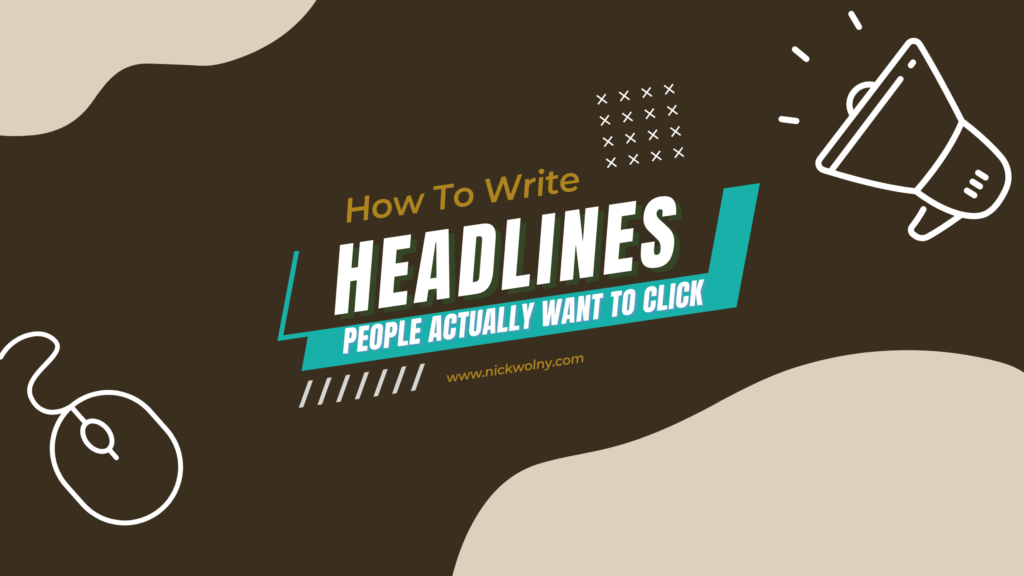Do you want more people to actually click and read your articles, email newsletters, and pitches?
Would increasing your total followers, email open rates, booked discovery calls, or sales campaigns be valuable to you?
1% of the words you write are responsible for 80%+ of the results. That 1% is.... your headline.
In this post, we'll break down why writing powerful headlines is critical for growing your audience online.
Why Care About Writing Powerful Headlines?
Many marketers feel a powerful headline can be as important, if not more important, than the content itself.
Headlines are so powerful they're part of what got us into this misinformation mess in the first place. A study found that 59 percent of articles shared on social media weren’t even clicked on by the user in the first place; users form an opinion or take action after just one sentence.
Headlines are a first impression for your readers; if you want people to read your work and learn from you, sharpen the skill of writing persuasive headlines now.
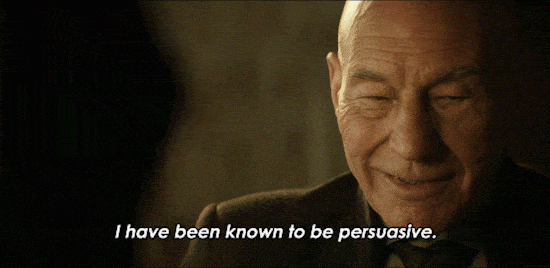
Whether your end goal is to educate, pitch, or sell, powerful headlines are a critical component in your online marketing efforts, and readers use headlines to make a snap judgment about your content.
PSA: People will make time for content that matters to them
The notion that people don’t have time to read is misguided. Your audience will always make time to consume content if the subject matter is compelling. Research has shown that when we’re curious, we’re more likely to expend precious resources such as time to find out the answer.
When zinged by a great headline, readers will drop everything to consume. The job of a powerful headline – and your overall copy as a creator – is to deliver an emotional charge that suspends logic and creates psychological tension that can only be relieved with a click.
There's an old copywriting adage:
"The only goal of any sentence is to inspire the reader to move on to the next sentence."
The good news is that you don’t have to be a wordsmith or a literary genius to write great headlines. An effective headline isn’t about the words, but rather the brain science in play when someone pauses to read. 🧠
Let's look at a few headlines used by big media publications – companies whose headline effectiveness literally makes or breaks revenue goals.
Examples Of Persuasive Headlines
"Stanford psychology expert: "This is the #1 work skill of the future""
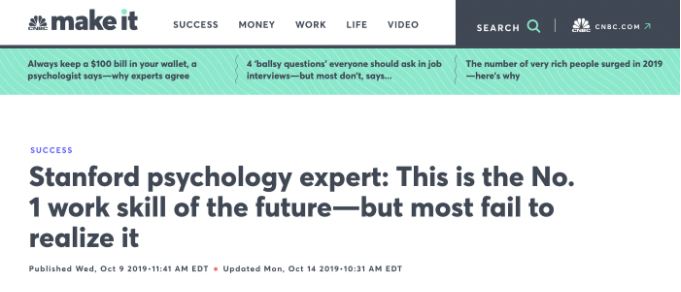
This headline from CNBC is simple, but a copywriter’s dream. Here are some of the elements that make it so effective:
➡️ It’s a one-item list. Rather than 7, or 11, or 23 work skills, there’s just one skill I need to learn and improve, which feels achievable.
➡️ It's futuristic. Describing the “work skill of the future” is a clever way to drive urgency, since the future is impending for everyone.
➡️ It features someone smarter than us. I assume the expert commentary is smart and researched because it’s a professor at a prestigious university — someone’s ass is on the line that this material is high quality and accurate.
"How others see you, based on your personality type"
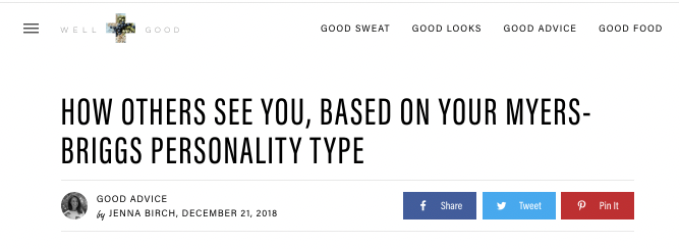
We’re social creatures and have a deep curiosity about how others view us. Additionally, anything backed by science or protocol feels more trustworthy and credible. This headline from Well + Good effectively connects both of these triggers.
Did you know that "personalization" consistently gets named a top marketing trend? Readers want information and services that are customized for them.
➡️ Personalized chat boxes that get your questions answered quickly
➡️ Recommendations from an algorithm based on your browsing history or purchase history
➡️ Diagnostic tools that will help you figure out who the hell you are and what you should become when you grow up 🤷🏻♂️
Anything that feels unique to your reader will capture their attention and quench their thirst for relevance. Sprinkling in a popular personality assessment system gives this headline some punch.
“A beginner’s guide to buying, cooking, and eating more and better vegetables”
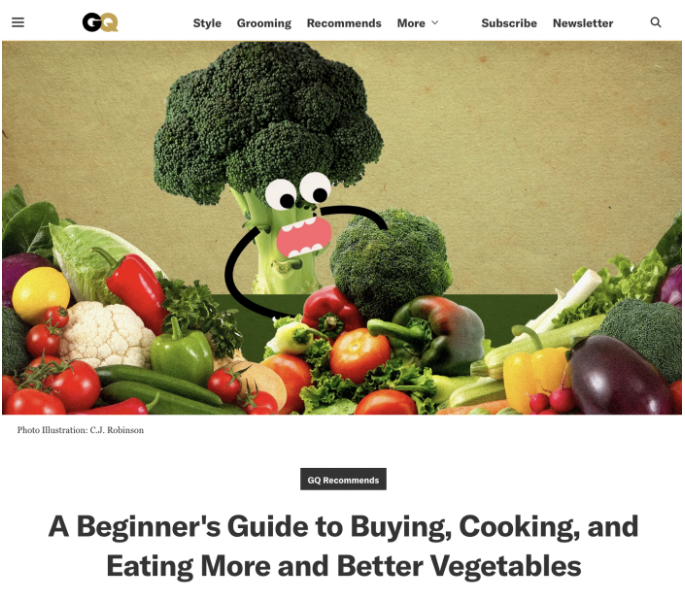
Keep it simple! This headline from GQ is direct and descriptive without being too wordy.
One reason this headline is so effective is that it touches on multiple pain points all at once.
➡️ Don't know how to cook tasty vegetables? This guide is for you.
➡️ Cook regularly, but never eat the leftovers? This guide is for you.
➡️ Avoid shopping for produce altogether because you're not sure what to look for? This guide is for you, too.
The "multiple pain points" strategy results in a larger engaged audience.
*
Are we excited about headlines yet? I am! Now let's transition into 4 copywriting tips you can start implementing today to write powerful headlines.
4 Psychology-Backed Copywriting Tips (Click link to jump to the tip)
Powerful Headline Tip #1: Leverage Urgency And Scarcity
To win the click or the sale, you must not only answer the reader’s question of “Why this?”, but also “Why this now?”. Copywriters thread urgency and scarcity into a headline to elicit fast action.
Urgency creates a psychological experience in which we feel we must consume the information or product now, not later.
The secret sauce of urgency is that it causes the emotional part of your brain, the amygdala, to activate and temporarily outrun your systems of information processing, housed in your frontal lobe.
Psychologist Daniel Goleman coined the term “amygdala hijack” to describe this sometimes-irrational fear response; we want this in copy because it means emotion has taken over.
- Scarcity technically falls under the umbrella of urgency. A good way to delineate the two is that scarcity usually highlights limited supply; even if you were to act within the given time window, you may still miss out.
“5 spots left – you in?” is a classic email newsletter subject line packed with scarcity and speed. If you don’t act right now, you risk missing out on the opportunity.
Scarcity doesn’t always have to be supply-related. Last-chance language can stir up similar emotions – “Last day for purchases to arrive by Christmas” is an effective headline for product-backed businesses or disappearing bonuses. Examples like these are where the line between urgency and scarcity gets a little blurred, but you get the idea.
Be cautious about using fake urgency and scarcity – if you say the added bonus expires on Friday, then continue to promote it again and again, you risk eroding confidence and trust in your brand.- Reader validation is one common way to achieve this emotion. In this copywriting technique, we tap into the reader’s fear of being an impostor or not belonging. The example headline “9 Truths About Morning Productivity Only Successful People Know” encourages you to click and read if you perceive yourself as a successful person; you want to self-validate, see which truths you already know, and perhaps learn a few new ones.
- Passage of time is another effective urgency trigger that highlights the pain of being held back. Will the prospective reader feel left behind in their career or life if they don’t click? “Last workshop of 2019 closes this Friday” elicits pain if the reader could benefit from attending the workshop now rather than later.
- Scarcity refers to the number that are available. It creates speed in a different way – in this case, your thought process gets disrupted by the realization that what you want is almost gone.
Powerful Headline Tip #2: Get Specific
Specificity creates a more vivid experience in the brain. The more real a headline feels to someone, the more likely they are to engage with your content. Two easy ways to create specificity are to use numbers and adjectives.
Numbers create specificity and engage the brain, especially when represented as a digit rather than a word (“5” instead of “five”). Numbers also help to outline the upcoming content, which saves your brain from having to enlist the logical part of your mind; as a result, your emotional brain continues to run the show.
Let me say that again. When you tell your reader how the subsequent content is going to be laid out, you keep them from having to go into information processing mode. In most cases, this approach keeps your reader on the page longer.
Research from Conductor also found that 36 percent of respondents prefer a number in the headline; numbers provide more detail in a compact way.
Descriptive adjectives also light up the reader’s brain and increasing the overall synaptic activity happening in the reader’s mind.
Adjectives can help to assert the desired end result. In the above examples, "Stanford professor", "Myers-Briggs personality type", and "Beginner's guide" all leveraged descriptive adjectives to create specificity and realness.
Embrace specificity!

Powerful Headline Tip #3: Drum Up Curiosity
An analysis by BuzzSumo of 100 million headlines showed that, when it comes to traffic and click-through, curiosity is king.
Curiosity lies on the reward pathway in your brain. We are wired this way as humans to incentivize exploration and survival; seeking out new information sometimes leads to a reward.
(This is why the previously mentioned technique of reader validation also works. Even when the information ends up not being new, self-validation also ignites our brain’s reward systems.)
Research also implies that our brains assign more dopamine to the learning of information we didn’t previously know.
Dr. Todd Kashdan, a lifelong researcher on curiosity, notes in a study that there are different flavors of curiosity and different sensitivities to each from person to person.
For some readers, dangling a puzzle to solve will get the click, while for others a more effective trigger is to pull back the curtain and reveal how a certain group of people approach a topic.
The latter approach was leveraged in the headline of this article--you want to know what copywriters take into consideration when crafting headlines.
Powerful Headline Tip #4: Be Clear And Concise
Optimal subject line and headline length is a controversial topic. Here are three conflicting reports that all assert different recommendations:
➡️ Outbrain researched that headlines that are 16-18 words in length tend to outperform ones that are shorter or longer.
➡️ Social media company Buffer, however, says an ideal headline is six words, and also backs up their claim with research.
➡️ And an analysis done by Mailchimp of their millions of users found that headline length didn’t impact open rate at all.
Which is correct? A good exercise for any entrepreneur is to practice getting the point across in as few words as possible to start. For experts or seasoned professionals, this brevity can be a workout.
When you develop this ‘skeletal’ headline style, you learn to pack more punch into each word. Explore 3-5 headlines that get the point across quickly, then go back over your headline options and add detail or adjectives only if they elicit more emotion from the reader.
*
Even as honest, hard-working entrepreneurs, we must stir up emotion in our headlines if we want to help our audience. Copywriting leverages the hard-wired emotional responses your readers will have to educate, inform and inspire.
Use these tactics and you'll encourage your audience to take action today and move closer toward their hopes, dreams, and goals.
Thanks for reading. 🙏🏼
Keep up the momentum with one or more of these next steps:
📣 Share this post with your network or a friend. Sharing helps spread the word, and posts are formatted to be both easy to read and easy to curate – you'll look savvy and informed.
📲 Hang out with me on another platform. I'm active on Medium, Instagram, and LinkedIn – if you're on any of those, say hello.
📬 Sign up for my free email list. This is where my best, most exclusive and most valuable content gets published. Use any of the signup boxes in this article, or go to the newsletter page here.
🏕 Up your marketing game: Camp Wordsmith™ is my business and writing program for small business owners and online entrepreneurs. Get instant access to resources and templates guaranteed to make your marketing hustle faster, better, easier, and more fun. (It's also "glamping"-themed – who doesn't love luxurious camping?!) Learn more here.
📊 Hire my marketing company: Hefty Media Group provides consultation and done-for-you services in content marketing. We're a certified diversity supplier with the National Gay & Lesbian Chamber of Commerce, and we'll make you sound damn good via the written word. Learn more here.
© 2021, 2022, Hefty Media Group. All Rights Reserved.

